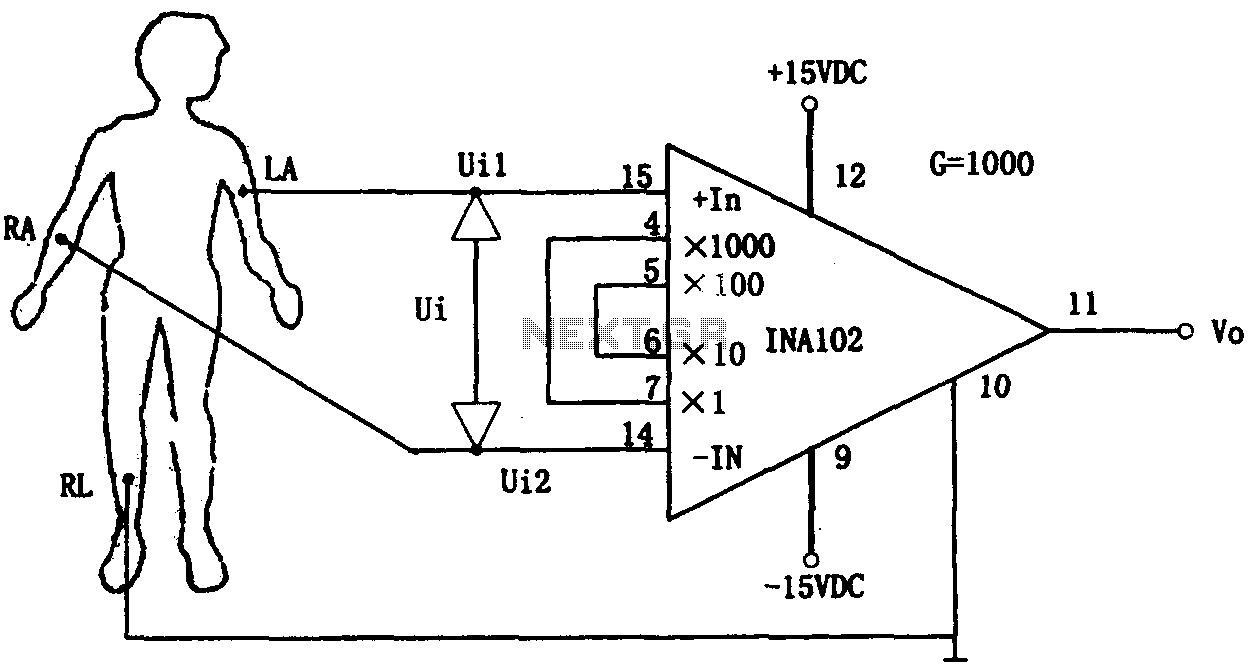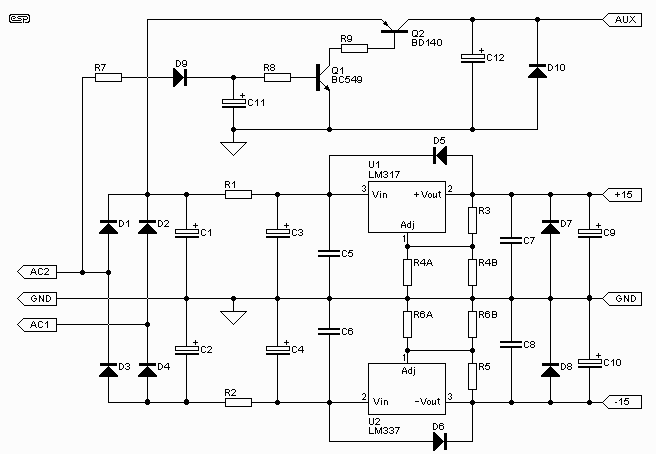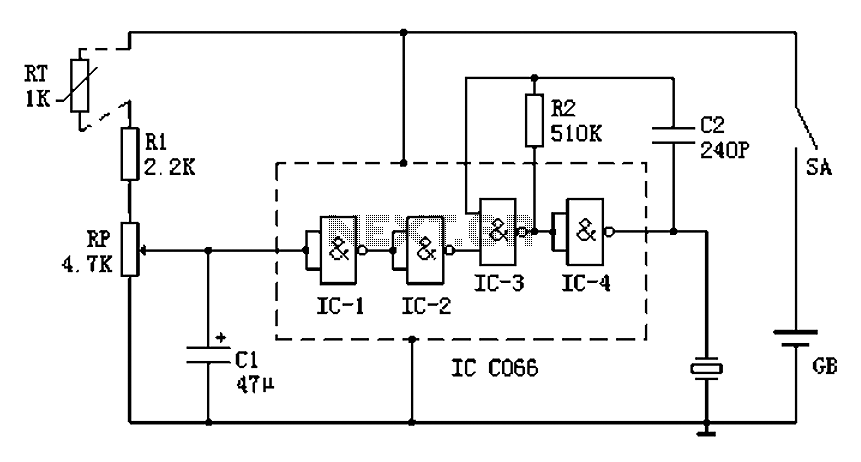
Human biological signals consisting of a preamplifier circuit INA102

This document outlines a preamplifier circuit designed for measuring human biological signals, such as ECG and EEG. These biological signals are typically weak and require high amplification circuits. The circuit utilizes a low-power integrated operational amplifier, INA102. The INA102 features a small quiescent current (up to 750 µA) and provides selectable gains of 1, 10, 100, and 1000 through different connection pins, specifically pins 4, 5, 6, and 7, which can be configured to achieve the highest gain of 1000. The amplifier exhibits high gain accuracy and drift (up to 5 x 10^-6 / °C), a common-mode rejection ratio of at least 90 dB, a minimal offset voltage (maximum 100 µV), low non-linear distortion (maximum 0.01%), and a small offset voltage drift (maximum 2 µV/°C). The circuit's voltage amplification factor is set to 1000, allowing for an output voltage peak value of up to 1V.
The preamplifier circuit for human biological signals is critical in medical instrumentation, where precision and sensitivity are paramount. The INA102 operational amplifier is specifically designed for such applications, ensuring that weak bio-signals are amplified adequately for further processing. The choice of a low-power device is advantageous in wearable medical devices, where battery life is a concern.
The configurable gain options enable flexibility in various applications. For instance, lower gains may be suitable for signals with higher amplitudes, while higher gains are essential for weak signals like those from EEG electrodes. The common-mode rejection ratio (CMRR) of at least 90 dB is particularly important in biological signal measurement, as it minimizes the effects of noise and interference from other electrical signals in the environment, ensuring that the output primarily reflects the biological signal of interest.
The specifications of the INA102 make it suitable for use in environments where precision is critical. The low offset voltage ensures that the output signal accurately represents the input signal without significant error, while the low distortion characteristics maintain the integrity of the biological signal. This is vital in clinical settings, where accurate measurements can impact diagnosis and treatment.
Overall, the preamplifier circuit employing the INA102 operational amplifier is a robust solution for amplifying human biological signals, providing the necessary performance characteristics for effective and reliable medical monitoring.Shown for the human biological signals preamplifier circuit. In the medical equipment often need to measure the bodys biological signals such as ECG, EEG. Since biological signals are weak, it is very high amplification circuits. The circuit used with a low-power device integrated operational amplifier INA102. The integrated chip INA102 features are: small quiescent current (up to 750 A); internal gain through different connection pins varies, which has selectable gain: l, 10,100 and 1000, the figure pin 4, 5, 6 and 7 is connected to the pin can be connected to the largest gain of 1000; high gain accuracy and drift (up to 5 10-6 / ); common-mode rejection ratio (minimum 90dB); a small offset voltage (max l00 V); small non-linear distortion (maximum 0.01%); small offset voltage drift (max 2 V / ); high input resistance (1010 ). The circuit voltage amplification factor of 1000, the output voltage peak value of up to 1V.
The preamplifier circuit for human biological signals is critical in medical instrumentation, where precision and sensitivity are paramount. The INA102 operational amplifier is specifically designed for such applications, ensuring that weak bio-signals are amplified adequately for further processing. The choice of a low-power device is advantageous in wearable medical devices, where battery life is a concern.
The configurable gain options enable flexibility in various applications. For instance, lower gains may be suitable for signals with higher amplitudes, while higher gains are essential for weak signals like those from EEG electrodes. The common-mode rejection ratio (CMRR) of at least 90 dB is particularly important in biological signal measurement, as it minimizes the effects of noise and interference from other electrical signals in the environment, ensuring that the output primarily reflects the biological signal of interest.
The specifications of the INA102 make it suitable for use in environments where precision is critical. The low offset voltage ensures that the output signal accurately represents the input signal without significant error, while the low distortion characteristics maintain the integrity of the biological signal. This is vital in clinical settings, where accurate measurements can impact diagnosis and treatment.
Overall, the preamplifier circuit employing the INA102 operational amplifier is a robust solution for amplifying human biological signals, providing the necessary performance characteristics for effective and reliable medical monitoring.Shown for the human biological signals preamplifier circuit. In the medical equipment often need to measure the bodys biological signals such as ECG, EEG. Since biological signals are weak, it is very high amplification circuits. The circuit used with a low-power device integrated operational amplifier INA102. The integrated chip INA102 features are: small quiescent current (up to 750 A); internal gain through different connection pins varies, which has selectable gain: l, 10,100 and 1000, the figure pin 4, 5, 6 and 7 is connected to the pin can be connected to the largest gain of 1000; high gain accuracy and drift (up to 5 10-6 / ); common-mode rejection ratio (minimum 90dB); a small offset voltage (max l00 V); small non-linear distortion (maximum 0.01%); small offset voltage drift (max 2 V / ); high input resistance (1010 ). The circuit voltage amplification factor of 1000, the output voltage peak value of up to 1V.





